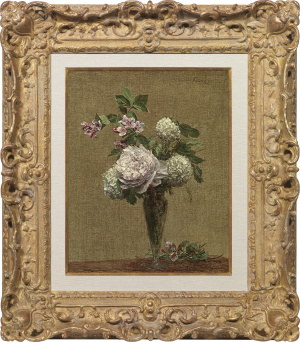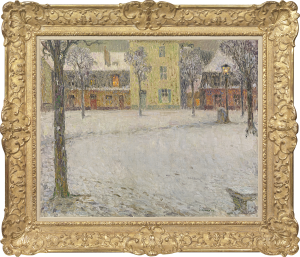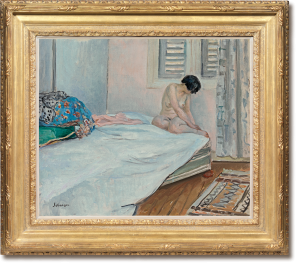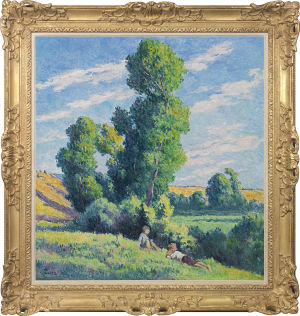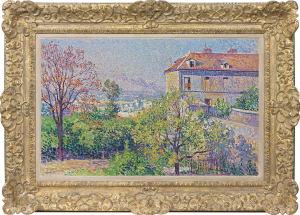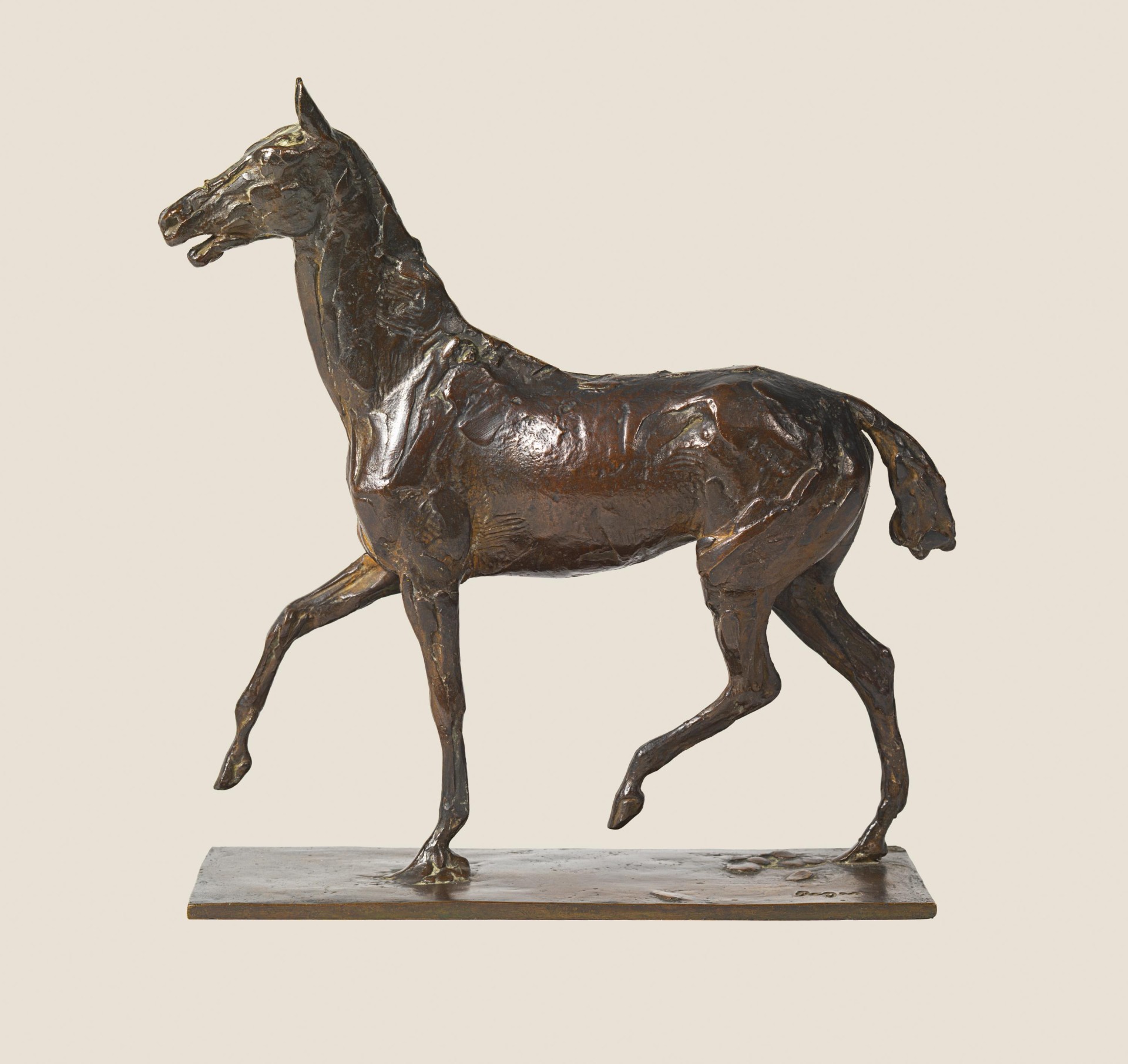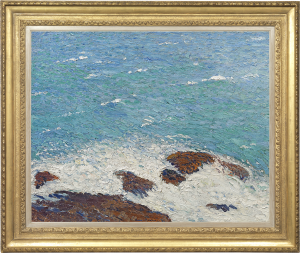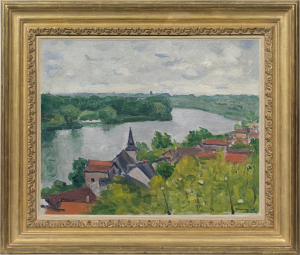Francis Picabia
Dans les collines, effet de soleil, Fuenterrabia
Oil on canvas: 21.3 x 25.6 (in) / 54 x 65.1 (cm)
Signed and dated lower left: Picabia 1907
This artwork is for sale.
Please contact us on: +44 (0)20 7493 3939.
Email us
FRANCIS PICABIA
1878 - Paris - 1953
Ref: CC 177
Dans les collines, effet de soleil, Fuenterrabia
Signed and dated lower left: Picabia 1907;
signed, dated and inscribed on the stretcher: Picabia dans les collines effet de soleil 1907 /Fuenterrabia /Espagna
Oil on canvas: 21 ¼ x 25 5/8 in / 54 x 65.1 cm
Frame size: 29 x 33 in / 73.6 x 83.8 cm
In a Louis XIV style carved and gilded pastel frame
Provenance:
By descent in a private collection, France, since the 1960s
To be included in the catalogue raisonné of the work of Francis Picabia being prepared by the Comité Picabia
Born in Paris in 1879 into a wealthy Franco-Cuban family, Francis Picabia brimmed with confidence and naturally embraced the avant-garde, becoming in later life an exponent of Dada and Surrealism. He studied at the Ecole des Beaux-Arts with Fernand Cormon and attended the Ecole des Arts Décoratifs from 1895 to 1897, but by 1904 had sloughed off the dark palette of academic painting to engage with Impressionism. He was particularly influenced by the work of Camille Pissarro, a political free-thinker constantly open to new artistic influences, and by that of Alfred Sisley, with his intense and highly personal response to nature.
Positioning himself as a student of nature, a free, instinctive painter, Picabia declared: ‘My school is the sky, the countryside, whether desolate or picturesque, the lanes, the valleys, life in the open air. The sun is the great master’[1]. He made his Paris debut with a one-man exhibition at the Galerie Haussmann in 1905, followed by another in February 1907. Society ladies swooned at his dark good looks; the critics were ecstatic. Léon Roger-Milès described Picabia in the 1907 show as ‘a virtuoso, seated his keyboard, plucking scales’, who ‘launches into an escalade of arpeggios or preludes at random, according to his psychic disposition’[2].
Buoyed by this success, Picabia, an early, enthusiastic adopter of the newfangled automobile, treated himself to a new car. He set off for the land of his forefathers, the Basque Country, no doubt driving like Mr Toad. Dans les collines, effet de soleil, Fuentarrabia is a fruit of this tour. Fuentarrabia (Hondarribia in Basque) is a border town on the river Bidasoa, the first on the north-western Spanish coast. It faces Hendaye in France across the harbour, which Picabia also painted on this trip[3]. Unsurprisingly, it has been much fought-over down the centuries. Fuentarrabia’s border status echoes Picabia’s mixed Basque-Cuban-French heritage: although Paris-born and a French citizen, he was proud of his Latin roots. They contributed to a fiery, restless nature that was ever questing for new means of expression, in art as in life.
Picabia in 1907 said that his aim was to ‘reproduce the emotion which nature made him feel without the least care for technique’[4]. In fact technique contributes powerfully to the impact of Dans les collines. The composition has a monumental simplicity, with its single tree, farmhouse, bay and sweep of blue-shadowed hills. Rich impasto, with the interweaving of myriad touches of colour, gives vibrancy to the painting. Picabia works the sky more thinly, with circular strokes, creating a pulsating radiance of blue heavens and white clouds with the faintest touch of pink, emphasizing by contrast the sculptural solidity of the dense vegetation. Like Renoir in his twentieth century landscapes, Picabia moves beyond the Impressionist desire to capture a single moment in nature, in favour of responding to the essence of a scene.
Effet de soleil dans les collines à Fuentarrabia, 1907 (private collection) seems to show the farmhouse near the sea in Effet de soleil en bord de la mer à Fuentarrabia from another angle, but in similar conditions of light[5].
FRANCIS PICABIA
1879 – Paris – 1953
Exuberant, extravagant and individualistic, Francis Picabia was one of the most influential artists of the first half of the twentieth century. Born in Paris in 1879 of wealthy Cuban and French parents, he studied at the Ecole des Beaux-Arts with Fernand Cormon and attended the Ecole des Arts Décoratifs from 1895 to 1897.
Picabia’s first works were Impressionist landscapes influenced by Pissarro and Sisley. In 1909 he married the musicologist Gabrielle Buffet (they divorced in 1931), with whom he shared an interest in the avant-garde. Picabia adopted the harmonies of form, colour and movement outlined by the poet Guillaume Apollinaire in his definition of Orphism (1912) and exhibited works with the Section d’Or that year.
In 1913 Picabia exhibited at the Armory Show in New York which introduced the French avant-garde to America. The jazzy rhythms and frenetic pace of New York life were reflected in his dazzling, fractured gouaches, echoing the Futurists’ obsession with modern urban life. Picabia spent the First World War in New York, Barcelona and Switzerland, collaborating with Alfred Steiglitz at his 291 gallery and developing Dada with Marcel Duchamp. Duchamp’s concept of the ‘ready-made’ influenced Picabia’s works in which machine parts express human sexuality, ridiculing bourgeois art and morality. In Barcelona in 1916, Picabia began to publish the magazine 391, which had a decisive influence on Dada in France. From 1919 to 1924 he produced his most seminal Dadaist works in Paris, the butt of public outrage, but applauded by critics such as André Breton. Typically averse to confining himself to one style, he also painted large, pseudo-Classical figure compositions.
In 1925, considering that Dada had become far too mainstream, Picabia used a large inheritance from his uncle, Maurice Davanne, to buy a house at Mougins, near Cannes. He produced a series of Monsters, figures with doubled eyes and quivering outlines, and Transparencies (1927-c.1931), figures transposed onto landscapes and flowers in a mélange of shifting visions. Both mockingly reflect the great tradition of European painting, with motifs from Michelangelo, Titian and Rubens.
In the late 1930s Picabia experimented with abstract painting. His brash Hollywood nudes, produced during the Second World War, have been seen as precursors of Pop Art. In 1940 he married Olga Mohler, the former nanny of his son Lorenzo by his mistress Germaine Everling. They returned to Paris in 1945. Picabia continued to experiment and also to re-explore elements of his previous styles, often overpainting earlier works. He died in Paris on 30th November 1953.
The work of Francis Picabia is represented in the Museum of Modern Art and the Guggenheim Museum, New York; the Art Institute of Chicago; Philadephia Museum of Art; Tate, London; the Pompidou Centre, Paris; the Kunsthaus, Zurich and the Reina Sofia Museum, Madrid.
Susan Morris
[1] Quoted in Maria Lluïsa Borràs, Picabia, London 1985, p.49.
[2] Quoted in William A Camfield et. al., Francis Picabia Catalogue Raisonné Volume 1 1898-1914, Brussels 2014, p.52.
[3] Les deux jumeaux à Hendaye, 1907 (private collection); Camfield 2014, op. cit., p.264, no.308, illus. in colour.
[4] Quoted in Camfield, ibid., p.52.
[5] See Camfield, ibid., p.264, no.310, illus. in colour.






